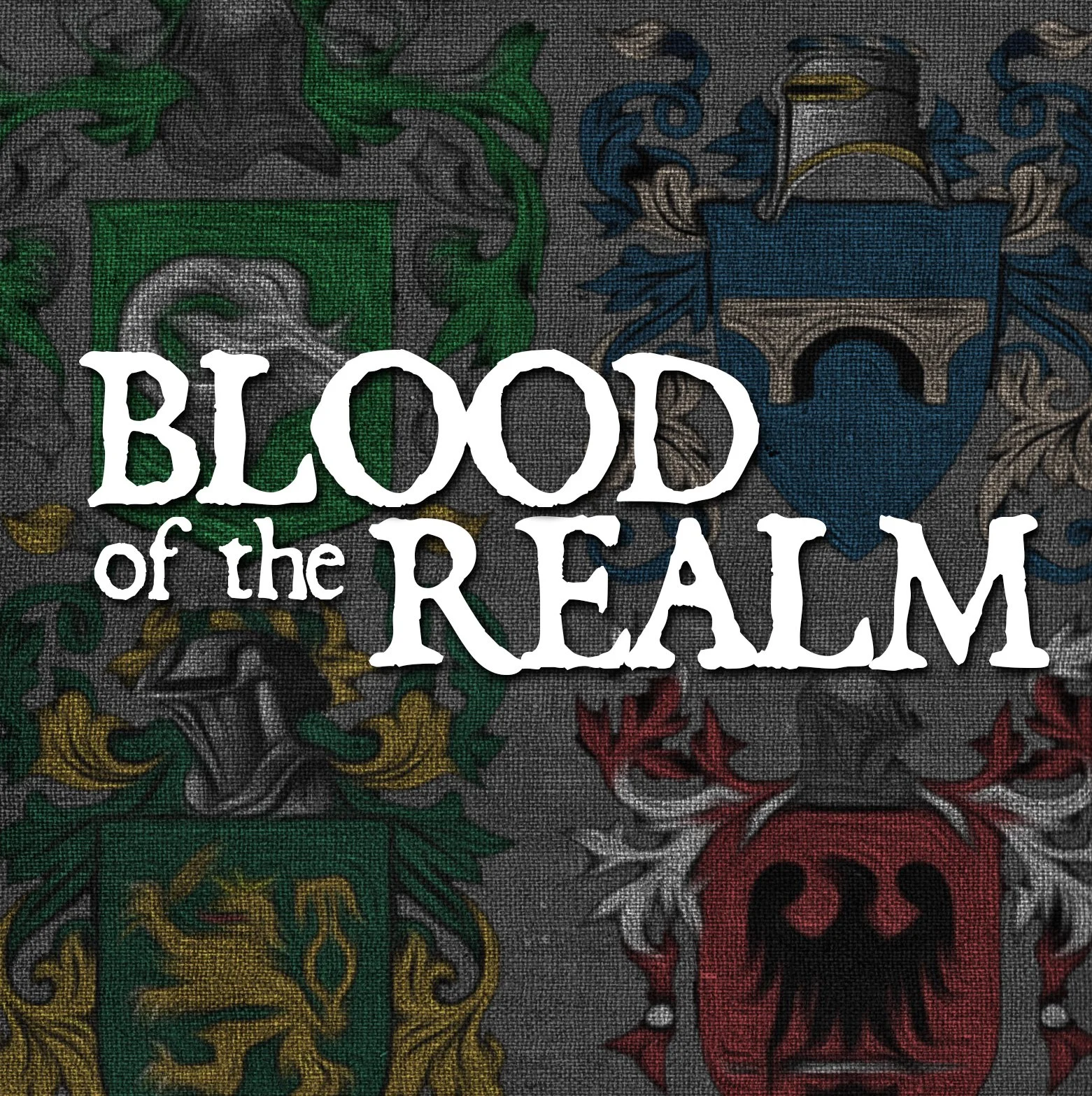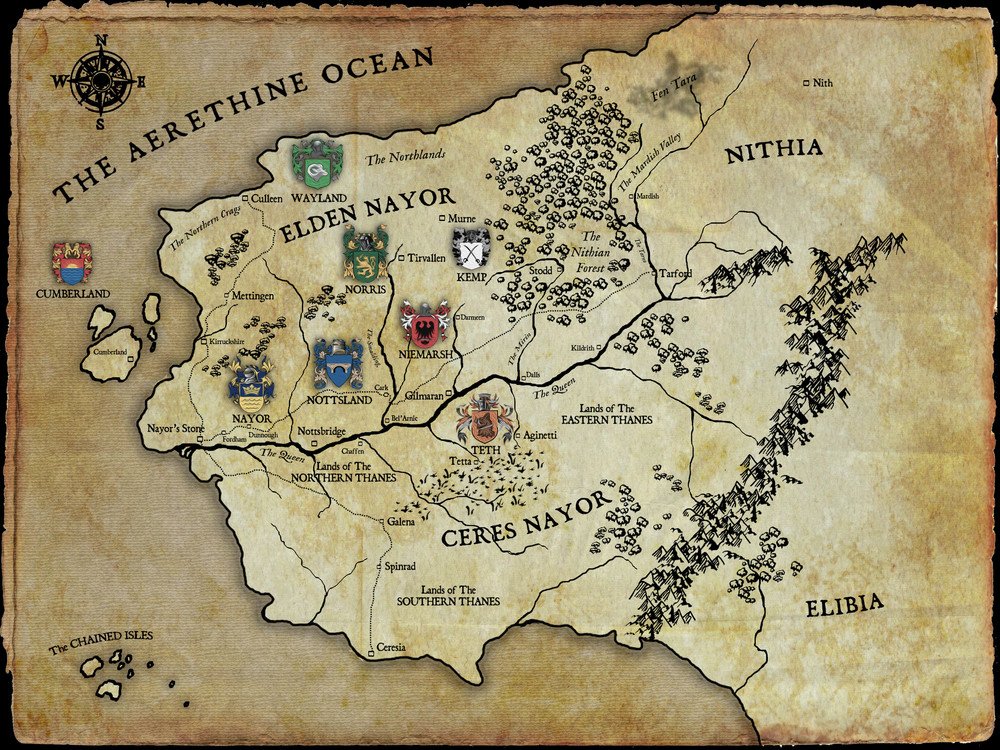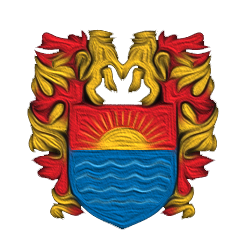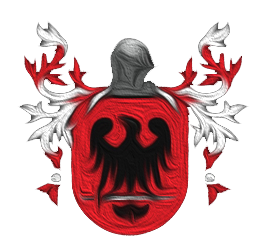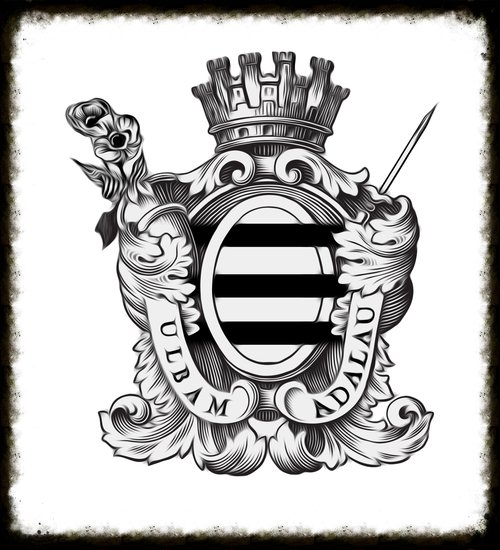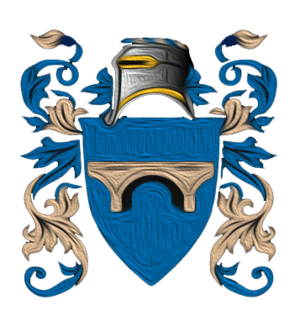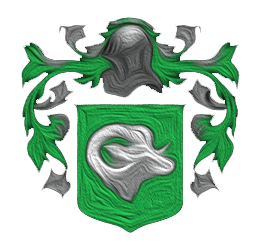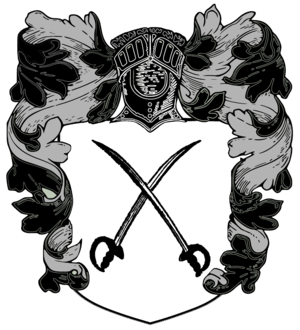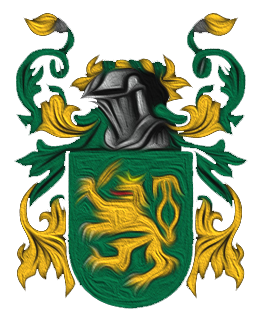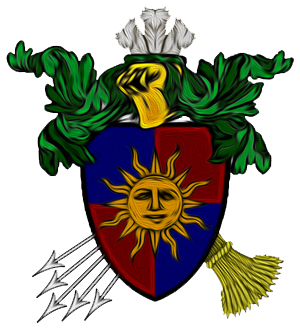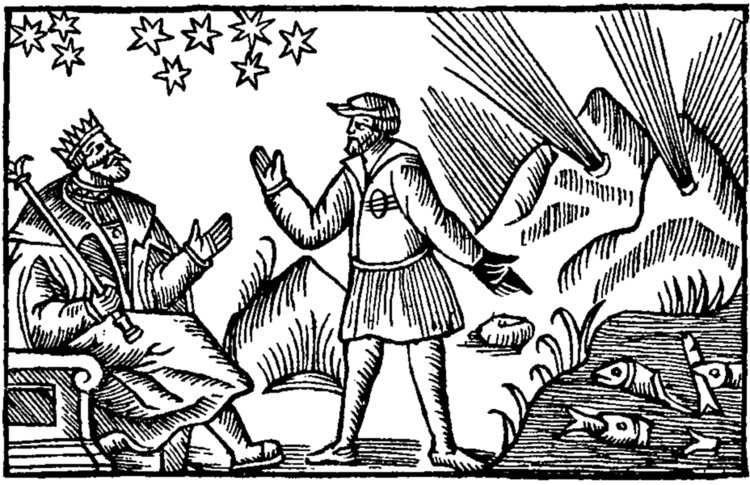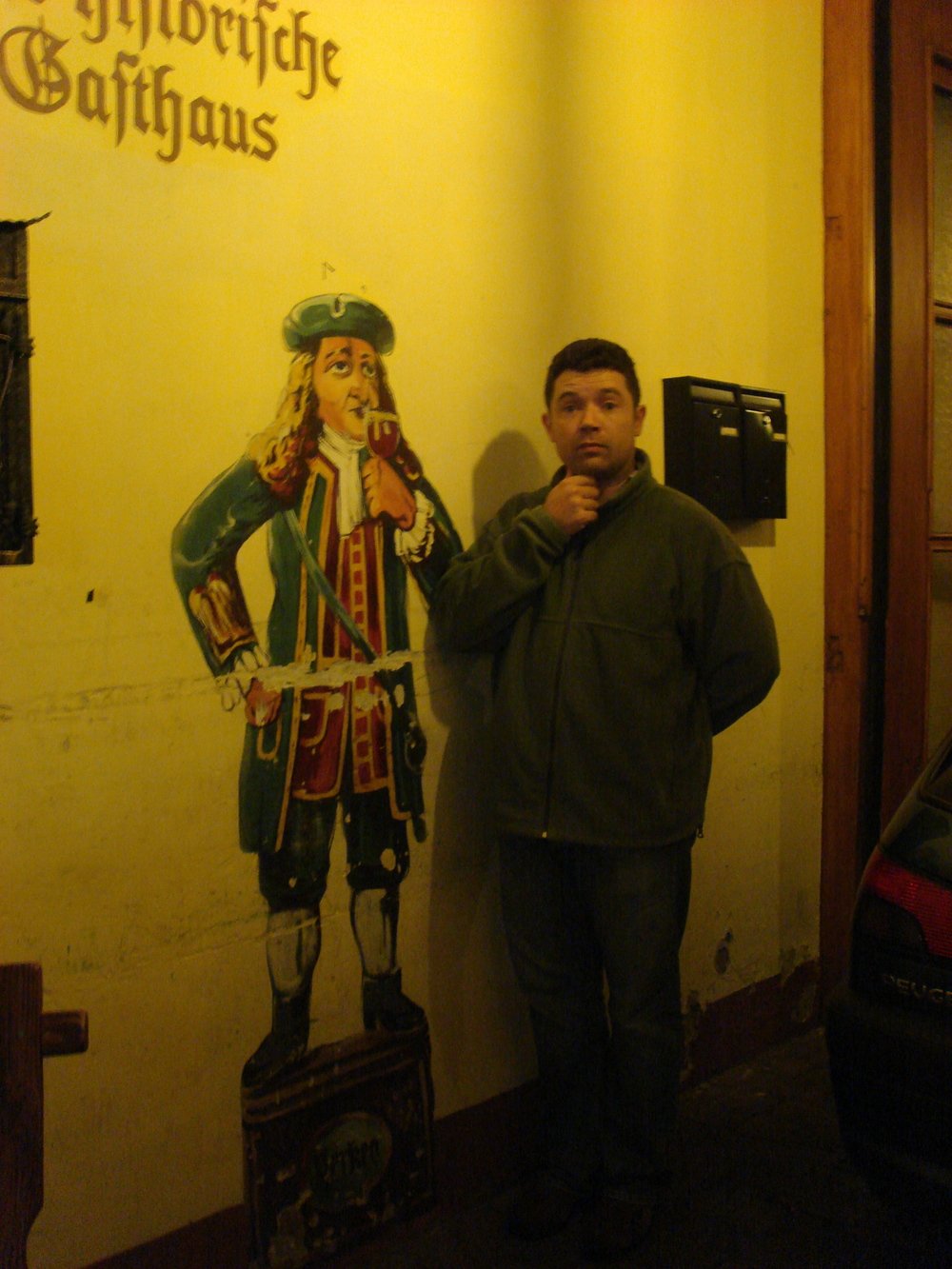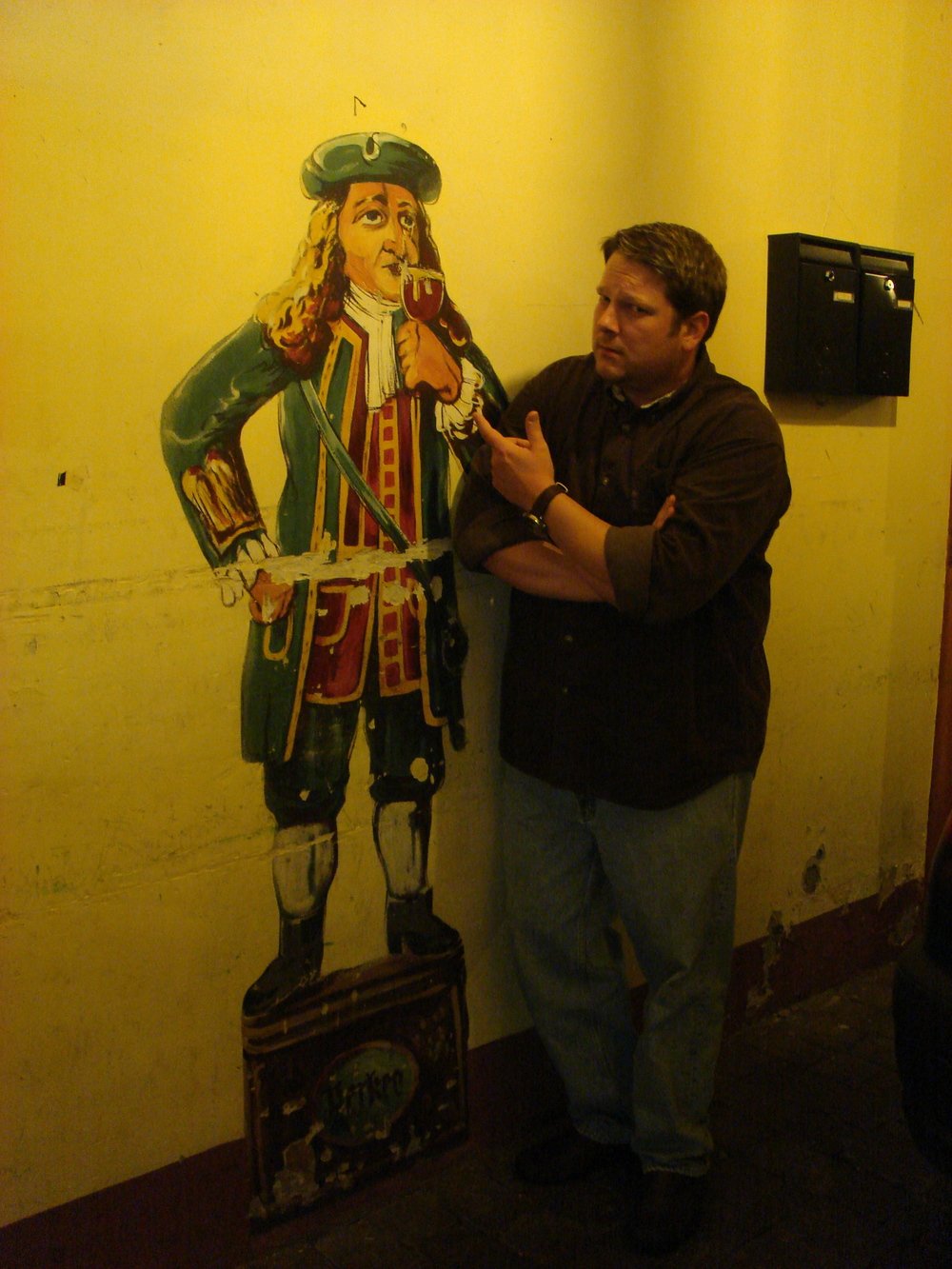BLOOD OF THE REALM: EPIC FANTASY FICTION
Book 1 of The Nayoran Saga
For three centuries House Albareen has ruled the Nayoran Peninsula, enduring through invasions, uprisings and the endless machinations of the highborn.
Now the Albareen siblings—Gwendoline, Malcolm and Jerrith—face their most desperate hour. Their father, the king, is in decline. Rival Houses plot to seize the throne. A cabal of mages, outlawed and persecuted, grows closer to re-discovering their ancient strength… and with it, the power to conquer the Peninsula.
Or to destroy it.
Blood of the Realm is the first novel in The Nayoran Saga, an epic fantasy series by Lee Sanders & Michael McNelly.
THE Nayoran PENINSULA: NOBLE HOUSES
House Albareen
The current rulers of Elden Nayor, House Albareen rose to power in AN 956, when Larkin Albareen ascended the throne (ending the 108-year rule of House Rotswald). The inception of their rule coincided with the end of the Age of High Sorcery, and the outlawing of magic throughout the realm.
The Albareen rule from Nayor's Stone, the largest and most important city in Elden Nayor. Its Queensbridge, constructed by the Etherine Order in AN 879, was the first of its kind, and still serves as a major conduit for goods and travelers.
The royal palace of the Albareen, The Stone, was constructed over several generations, beginning c. AN 11. It has served as the seat of power through three ruling families: House Nayor (AN 1 – AN 848); House Rotswald (AN 848 – AN 956); and House Albareen (AN 956 – present).
Notable figures of House Albareen include Larkin Albareen (b. AN 919), first Albareen ruler of Elden Nayor; Kieran IV Albareen (b. AN 1127), during whose reign the Queensbridge at Nottsbridge was destroyed; and Barnard I Albareen, who signed the Peace of Nayor in AN 1245.
The most recent generation of Albareen include Gwendoline (b. AN 1248) and twin sons Malcolm and Jerrith (b. AN 1252).
House Niemarsh
An ancient family, House Niemarsh traces its lineage from Nithia in the generations before the establishment of the Eight Kingdoms of the North (which were subsequently unified by King Elden Nayor in AN 1).
Ruling from Gilmaran, seat of the duchy, House Niemarsh controls a wide portfolio of goods and services vital to the prosperity of the realm. Their Queensbridge is key to this prosperity.
Built in AN 895, the vast bridge spans the Queen, the mighty central river of the Nayoran Peninsula. Along with the Queensbridge at Nayor's Stone, it is one of only two such bridges still in existence (the third, at Nottsbridge, was destroyed in AN 1145).
Possessing two edifices from the Age of High Sorcery (the Queensbridge and the Time Tower, constructed in the central square in AN 832), Gilmaran is second in importance only to Nayor's Stone as a hub of commerce and politics.
House Niemarsh is currently ruled by Duke Varden Niemarsh, who, along with his son, Aaron, are among the most politically influential nobles in Elden Nayor.
House Hanlan
House Hanlan is a relatively young noble house, having ascended to the rulership of the Duchy of Norris only within recent generations (House Norris itself being extinct). The lands of Norris lie in the heart of Elden Nayor; the River Smalding is their chief geographical feature.
The current matriarch of House Hanlan, Mardetta Hanlan-Cavish, Fourth Duchess of Norris, wields considerable power. Her fiefdom provides both crops and manufactured goods for the entirety of Elden Nayor, and under her cautious stewardship Norris has added to its territories (primarily by pushing south into the neighboring lands of Nottsbridge).
Duchess Hanlan-Cavish—"Mags," as she is called among her circle of intimates—is childless, and a widow. As a result, her nephew, First Regent Garret Hanlan, is considered her most likely successor.
House Hanlan rules from the Keep at Tirvallen, but they reside at their ancestral home of Park Hanli during the majority of the year.
House Kemp
House Kemp traces its ascendancy to AN 310, with the first Nithian military incursions west of the Nithian Forest.
Situated in the hardscrabble northeastern corner of the Eight Kingdoms of the North and sworn to House Langren, the minor nobles of House Kemp were generally ignored by the other great Houses of the realm.
All that changed in AN 395, when Lord Belden Kemp rallied what remained of the Nayoran forces to achieve a major victory at the Battle of Murne. The battle halted the momentum of the Nithian army, which had previously seemed poised to conquer the entirety of Nayor.
Intermittent skirmishes and even large-scale engagements between Nayoran and Nithian forces would continue for another century, but the Nithians never again achieved significant advantage.
For his valor, Lord Kemp was granted a wide swath of land bordering the Nithian Forest (which lay vacant; Nithian soldiers had put every living member of House Langren to the sword). Along with the lands came the title First Earl of Kemp, and the ongoing task of keeping the Nithians at bay.
This task has defined House Kemp ever since. Apolitical and insular, the House traditionally delivers superior fighting stock for the musters of Elden Nayor. The Paladine of Kemp are likewise reputed for their hardiness, their discipline, and their horsemanship.
Notable figures of House Kemp include Belden Kemp (see above); and, more recently, the late Louis of Kemp (AN 1245–1265), whose untimely death in a hunting accident puts the future of this stalwart House into question.
House Wrotham
House Wrotham of Cumberland was once among the most respected noble families in all of Elden Nayor. Within the last generation, however, it has fallen further than perhaps any House of the Peninsula.
The Barony of Cumberland is small (one main island and a handful of smaller, surrounding islands off the western coast of Elden Nayor), but it is vital to the realm. Its surrounding waters provide bountiful harvest for the fishermen who make up the majority of Cumberland lowborn. House Wrotham has also traditionally administered all Elden Nayoran maritime operations. The Keep at Cumberland, an unassailable tower of massive proportions that serves as the Wrothams' ancestral home, is one of the wonders of the Age of High Sorcery.
There is also a strong personal bond between House Wrotham and the Albareen: Baron Jan Wrotham was among the earliest staunch supporters of Duke Larkin Albareen's claim to the throne in AN 956, and subsequent Albareen kings have continued the tradition of friendship between the two Houses.
In recent years, however, the personal tragedy surrounding Miles Wrotham, Baron Cumberland, and his family has led to a general decline for Cumberland, and to questions regarding the future of this island fiefdom.
In AN 1250 Miles Wrotham's wife, Merewen, and son, Caeden, died as the result of a carriage accident (the details of which were never disclosed to the public) as they returned to Keep Cumberland from Nayor's Stone. The loss was a devastating one for the baron, who dismissed his personal staff and withdrew to the confines of his keep.
Since then Wrotham has seldom appeared in public. He has removed himself entirely from the affairs of court, and ceased correspondence with his relatives (a few distant cousins from a handful of lesser mainland Houses). The lowborn of Cumberland speak of their lord rarely; any disputes that may arise are settled by magistrates sent from Nayor's Stone. Naval affairs in Elden Nayor, never a high priority for the Albareen, have all but ceased. The few large vessels that compose the Elden Nayoran navy are anchored in the harbor of Cumberland's main island, unmanned and barely seaworthy.
The Rivermen have long coveted dominion over the seas as well as the inland waterways, and with the decline of House Wrotham they have repeatedly pressured the throne for saltwater authority. King Barnard I Albareen, however, has on every occasion exerted his royal prerogative to protect that portfolio on behalf of House Wrotham.
Other noble houses have yet to intervene in the matter, but it seems certain that the current generation of House Wrotham is its last. Who will replace them as lords of Cumberland remains an open question.
House MacGeill
The duchy of Wayland, ruled by House MaGeill, is a bleak swath of land stretching across nearly the entire northern coast of Elden Nayor. Its inhabitants are largely poor, unskilled and uneducated: tenders of sheep, cold-water fishermen, and farmers of what few crops can withstand the bitter cold of northern winters.
Wayland has thus long been regarded as a backwater, far removed from noble concerns and contributing little to the realm besides wool. House MaGeill has enjoyed a long and comfortable reign in these lands, however, and Wayland is among the most historically stable fiefdoms of Elden Nayor.
One possible reason for such tranquility is the easing of class distinctions characteristic of the north: Wayland stands nearly alone amongst noble Houses in its close relations with the commonfolk of the duchy. It is a familiar sight to see lords of the House engaged in falconry, or hunting, or simply partaking of a meal, with their lowborn neighbors. Unique also among these nobles is their use of the common vernacular (which perpetuates their unrefined reputation among other Houses).
It is thus unsurprising that House MaGeill does not field Paladine. The notion of a mounted cavalry soldier, tromping through snow and ice in full plate armor and elaborate barding, was long ago dismissed in favor of more terrain-appropriate forces.
Serving in their stead is the Wayl Guard. This cadre, comprising lowborn and highborn alike, is renowned for producing the finest archers in Elden Nayor (surpassing even the celebrated musters of Kemp). Another point of distinction is that they are continually operational, unlike the Paladine of most other Houses. In peacetime they serve the villages and cities of Wayland, mending fences, patrolling the eastern border, and hunting the predatory animals that would otherwise pose a constant danger.
The current Duke of Wayland, Colim MaGeill, is considered a strong supporter of the Albareen, due in part to his longstanding friendship with King Barnard's second wife, Mariss. The disappearance (and presumed death) of Mariss in AN 1253 seems only to have deepened the personal bond between Duke MaGeill and the aging Albareen patriarch.
Among the Duke's household are his wife, Wintifrid and a single daughter, Kemma.
House Anduval
A visitor to Nottsland in the early 10th century AN would encounter a charming, sophisticated fiefdom, celebrating the recent completion of its own Queensbridge (an event which occasioned the re-naming of the capital city, from Nottford to Nottsbridge).
The rulers of Nottsland, House Anduval, were exemplars of the nobility: benevolent, prudent, gracious. Proud of their recent prosperity, to be sure—the inclusion of the Queensbridge upon their coat of arms illustrates this—but beloved of the lowborn and their fellow highborn alike.
Two centuries later, none of these things would be true.
The death of King Kieran III Albareen in AN 1144, and the contested claim to legitimacy of his son, seventeen-year-old Kieran IV, resulted in a two-month period of turmoil in Elden Nayor. Nobles throughout the Peninsula vied to control the outcome of the succession. Some Houses (Norris and Wayland chief among them) stood in support of the Albareen. Others clamored for new rulership, citing the difficult decades following the end of the Age of High Sorcery.
Among the most vocal of these latter was Soren Anduval, Duke of Nottsbridge. After securing the support of several of the lesser Houses, he exploited a provision of Elden Nayoran law to attempt a violent coup.
By law, rather than owe fealty to an empty throne, the Paladine (the elite highborn cavalry of Elden Nayor) are bound only to their liege lords during an interregnum. The Duke of Nottsbridge took advantage of this rare situation. He called forth his Paladine, and the Paladine of those Houses sworn to his cause, and set them upon Nayor's Stone.
After a brutal series of battles (several of which, it is rumored, involved the use of magic on one or both sides—a crime punishable by death since AN 957) the Nottsbridge campaign was crushed and Kieran IV Albareen took the throne.
The new monarch's first actions were disastrous for House Anduval. Vast stretches of Nottsland were seized, becoming part of the Duchies of Nayor and Norris. As further punishment for his actions, Duke Soren Anduval was reduced in rank to Earl (the title still held by the lords of Nottsland).
Most damaging, however, was the final punishment proclaimed by the adolescent king: the destruction of the Queensbridge at Nottsbridge. Absent a reliable river crossing, traders, merchants, farmers and other lowborn departed (most to nearby Gilmaran, in the Duchy of Niemarsh). Nottsland was depleted of its most skilled lowborn within a generation, becoming what it is to this day: an ever-diminishing fiefdom of herdsmen and dirt farmers, beset by poverty and lowborn uprisings.
The current Earl of Nottsbridge is Falken Anduval. His well-documented enmity toward the Albareen has served only to worsen his position amongst the Houses of Elden Nayor, despite repeated overtures from King Barnard I Albareen.
Teth
(The Tethian coat of arms is unofficial, derived from the city crest of Tetta and commonly ascribed to the nascent House Pebblebrook)
Teth is unique in Elden Nayor. Technically a possession of the Duchy of Niemarsh, it nonetheless claims identity as a separate fiefdom, and its independence is the subject of much political debate amongst the Houses.
Situated in the heart of the Nayoran Peninsula, south of the Queen (another point of distinction for Teth; all other southern lands are considered part of Ceres Nayor, and thus the dominion of House Lombardosian), Teth is a land of rolling hills and pastures, dotted with picturesque villages and family farms. The climate is ideal, and Tethian wines are perhaps chief among the many delicacies prized throughout the Peninsula.
That Teth, and its titular head, Nicolo Pebblebrook (who holds title "Earl of Teth" by popular acclaim; House Niemarsh, of course, refer to him as merely a "Regent"), are allowed such effrontery is largely due to the vast quantities of luxury goods they grow, manufacture, and ship throughout Elden Nayor.
It is also likely that Pebblebrook's own enormous personal charisma and effectiveness as an administrator are a decisive factor. Pebblebrook is unwed, and, despite any number of proposed brides, he has yet to commit to a marriage. Instead, he has deftly maneuvered his fiefdom into trade alliances with various Houses in order to strengthen the Tethian claim to independence.
In addition, Teth has instituted a policy of remitting to his lowborn a portion of the revenues from the products of their lands. Those nobles who accuse Pebblebrook of attempting to buy the affections of the lowborn with gold Kingsheads find their argument difficult; the controversial policy has, so far, been an unqualified success. Productivity has risen, and the average Tethian lowborn enjoys a standard of living considerably above his neighbors in any direction.
Thus, while House Pebblebrook currently exists only hypothetically (i.e., as a House without a clear line of succession or ties of marriage to other nobility), in the minds of the Tethian lowborn there are few men more admired, more deserving of the title "noble," in all of Elden Nayor.
House Lombardosian
Until AN 1245, House Lombardosian was merely one of many noble factions in the lands south of the Queen. The signing of the Peace of Nayor in that year marked both the subjugation of the rival thanes of the region and the unification of Ceres Nayor as a single kingdom.
Vico Lombardosian, patriarch of his House and King of Ceres Nayor, is credited with bringing this unification without bloodshed. He is also praised for improving Ceresian relations with Elden Nayor and the Elibian Empire to the east.
Vico Lombardosian's lifelong vision of a unified Nayor is well known; achieving the Peace of Nayor is widely held to be but a step toward that goal. The political implications of King Vico's dream have resulted in a tense undertone to the otherwise cordial relations between himself and House Albareen.
Other notable members of the current House Lombardosian are Vico's wife, Sona Lombardosian, and their daughter, Alisia. The capital of Ceres Nayor is the ancient city of Ceresia, which lies along the southern coast of the Nayoran Peninsula. Its Great Gate, completed by the Etherine Order in AN 832, is among the most majestic works of the Age of High Sorcery.
***
The Rivermen
The Queen, the great central river of the Nayoran Peninsula, is vital to the prosperity of both Elden and Ceres Nayor. Countless tributaries flow to the Queen from every corner of the land, and upon this vast system of waterways are borne all manner of goods. From the humblest lowborn to the most powerful noble, all Nayorans depend on the Queen for their livelihood.
The Rivermen (officially the Honorable Guild of Rivermen) were chartered centuries ago to serve this need. Originally one of many workers' guilds involved in river trade, the Rivermen competed with (and eventually subsumed) guilds for deckhands, navigators, and longshoremen to achieve a total monopoly over freshwater travel.
The guild's ascendancy and longevity are a product of operational efficiency, political astuteness, and (according to some) a campaign of brutal intimidation against their rivals.
The Rivermen have been known to employ strongarm tactics against the nobility, as well. Their most common means of persuasion is docking, in which the captains of all water vessels in a particular fiefdom simply put to shore, refusing to sail until a given demand is met. In the less common case of a general docking, Rivermen halt all their traffic… bringing commerce to a standstill and threatening the stability of the kingdom itself.
These capabilities ensure that Rivermen Chiefs are habitually seated among the councils of the mighty; "the Law must float," as the saying goes among courtiers. Even the will of a King must be reconciled with the Rivermen's agenda before a decree can be proclaimed.
Thus the nobility and the Rivermen act in coalition, but always with a view to pressing their advantage. It is an open secret that the Houses have sought a credible rival guild for generations, working behind the scenes to break the Rivermen's power. And Rivermen are suspected as a matter of course when ill fortune befalls any noble.
The lowborn have another saying: "Never cross a Riverman." On more than one occasion a local card-sharp or cutpurse has been found at the water's edge, drowned and marked with an unmistakable stylized "R." The warning is clear: Rivermen do not tolerate effrontery, either as individuals or as a group.
The current Riverman chief is Drexel Barth. A commoner, Barth has nonetheless styled himself with a surname, after the noble fashion. Whether this should be interpreted as aspirational, or merely a reflection of the man's caustic sense of humor, is unknown.
***
The Etherine Order
THE ORIGINS OF MAGIC
The existence of magic has long been acknowledged, if poorly understood. In the earliest surviving Nayoran writings, depictions of the supernatural were confused and exaggerated, blended with local superstition and shamanic ritual practice. The resulting accounts were primitive and unreliable at best.
What is undisputed is this: to certain rare individuals, the raw substance of magic, the ether, is visible. And, to a still smaller number of people, it is tangible.
Centuries ago, a number of such adepts began to explore methods of enhancing their innate abilities. The experiments they conducted were unsanctioned and unregulated, often resulting in injury, insanity, death or worse. At length, though, the surviving adepts succeeded, discovering a formula of various natural substances (ingested, inhaled, or injected into the blood or under the skin) that amplified their ability to wield the ether, rather than merely perceiving or touching it.
These individuals were among the first who could properly be called mages.
INITIAL DEVELOPMENTS
Mages quickly formed loose confederations, each varying in structure and strength. It is also around this time, c. AN 500, that they were observed to bear similar physical characteristics: a gaunt, undernourished appearance, and—most consistently—a darkly stained left hand.
The significance of this stain became the object of much speculation. Was it a mark of affiliation? A side effect of touching the ether? Then, as now, the source of the stain is unknown, except perhaps to the mages and their intimates.
Most of these early cabals were little more than ragtag collections of novices, with a reputation for debauchery and erratic, often violent, behavior. In the villages where they congregated, sinister rumors spread. Discontent festered. Some cabals flourished for a period of weeks or months before disbanding, fading into obscurity. Others suffered the wrath of the lowborn and were forcibly exiled or killed outright.
Those mages who assembled in cities often ran afoul of the local magistrates, and it was in this period that hanging became the standard method of punishment for magic-related violations of the law. All in all, these early cabals did much to further the perception of mages as an untrustworthy, dangerous collection of degenerates. This dark reputation would adhere to magic, and those who studied it, ever after.
But one such group, the Etherine Order, would transcend these questionable associations, rising to prominence as the most consequential cabal of mages in the history of the Nayoran Peninsula. With the exception of the noble Houses themselves, the Etherine represent the most significant collection of individuals in all of Nayoran history.
THE EARLY ETHERINE
Little is known of the origins of the Etherine Order, save that an inner circle of nine Founders recruited members from throughout the Peninsula from c. AN 712 onwards. The earliest recorded use of the name "Etherine Order" dates to AN 746, in a personal correspondence between one Pirin'Adeel and a farmer named Briam, from the region now known as Teth.
From c. AN 761 – AN 957 the Etherine Order developed the study and practice of magic to hitherto unimagined heights. Alone amongst mages, the Etherine Order seemed immune to the detrimental physical effects of magical practice. They behaved with a discipline and restraint that had been lacking in their predecessors. Also notable is that few Etherine mages of the time bore the telltale stained hand that had become synonymous with magecraft.
As the Etherine worked ever-greater wonders, they reached out to lowborn and nobles alike in a campaign of goodwill that, if calculated, reached the desired goal. In time they gained audiences with the noble Houses, and worked closely with them to initiate an period of peace and abundance. Etherine mages were recognized as benefactors of the realm. They asked little in return save to be left to their pursuits, and to be allowed to share the results of those pursuits as they saw fit.
Above all, the early Etherine Order pursued knowledge. Despite the stupendous physical effects they could manifest, they considered themselves first and foremost an intellectual organization. A gathering of philosophers, rather than a tradesman's guild. Etherine mages consulted with, and shared their expertise with, the most learned men and women of the age.
Engineering was a field in which this collaboration bore particular fruit, as evidenced by achievements such as the Queensbridges, the Time Tower at Gilmaran, the Chained Isles, the Great Gate of Ceresia, and others (many of which have subsequently been destroyed or are otherwise lost to history). The scope of these marvels ushered in, not just a new power in the Peninsula, but a new Age.
THE AGE OF HIGH SORCERY
The Coat of Arms of the Etherine Order, c. AN 800. The Order's name is inscribed in Ceresian, with devices of unknown meaning surrounding the shield itself.
As the Age of High Sorcery dawned, the collected studies of the Etherine Order were codified, stored away in secret libraries and rationed out from master to apprentice (a process which could take decades). This was a system purpose-built by the Founders to advance the Art, while at the same time preventing a new generation of mages from using magic to their own ends without sufficient respect for the consequences of abuse.
Likewise, the Etherine organized themselves as a rigid, multi-tiered hierarchy, in which the nine Founders of the Order held authority over all mages who allied themselves with the group. Every aspect of the lives—and, more importantly, the research—of the Etherine was controlled from above. The specifics of mage politics during the Age of High Sorcery are, of course, unknown (unless, perhaps, they are chronicled in some volume of Etherine-held lore).
To the outside world the Etherine Order presented an anonymous, yet benevolent, face. Every season brought some new wonder to the realm. The obloquy of the lowborn began to subside (though it did not disappear entirely). The Etherine, alone among mages, held a great and growing power. They used it judiciously, for the benefit of all.
If the nobility had begun to view that superior power as a threat, they voiced such opinions only in the privacy of their halls. Outwardly they showered the Etherine with praise, and funded their ongoing endeavors with gold Kingsheads.
With the ascendancy of the Etherine, and the luxurious patronage of the nobles, came a new flowering of rival claimants to the Art. Mages who claimed allegiance to smaller cabals, or the rare "non-aligned mage," were treated with varying degrees of tolerance, depending on the political power of the Etherine at the moment… so long as those mages stayed far away from noble intrigue. Non-Etherine mages who curried favor with the nobles typically faced one of two fates: integration into the Order, or disappearance. Such was the Etherine manner of strengthening their emerging position as a political force.
By the last decades of the Age, the Etherine had become the de facto trade guild for magic—precisely the characterization they had long scorned. Always the Etherine strove to position themselves as the sole legitimate purveyors of magic across the Peninsula (a monopoly over the ether, in much the same way the Rivermen held a monopoly over the inland waterways).
For the most part, they were successful. The heights to which they had developed the Art, combined with shrewd political alliances and well-placed spies, ensured their preeminence. and they were able to assuage the growing wariness of the nobles through their continued services. Poor indeed was the lordling who lacked an Etherine advisor… always assigned by their Etherine superiors, of course, and ultimately answerable to the Nine Founders.
(The term "Nine Founders" was traditionally used by the Etherine to refer to their highest circle of authority. Whether the Founders were the same individuals throughout the Age of High Sorcery—a period of nearly 200 years—is unknown. Tales exist of the Etherine developing a means of extending their lifespan, as do other explanations of extreme longevity amongst the mages, but this may as easily be attributed to the general mystique surrounding the Order).
Whoever they were at this point, the Founders had good reason to insist on such rigid internal control. Rivalries within the Etherine were a growing source of tension as the 10th Century AN began. Professional disputes and simmering hostilities were inevitable, perhaps, with power of the magnitude that was wielded at the height of the Age. Inevitable, too, was a growing entanglement in noble politics. From time to time these internecine conflicts expanded beyond the walls of the Etherine strongholds. In at least one such case, Etherine mages came into contention with the Elden Nayoran throne itself.
An Etherine advisor to the king, from a woodcut c. AN 840.
THE WINTER REBELLION
The Winter Rebellion (AN 872) began in the midst of the Age of High Sorcery. A cabal of renegade Etherine mages supplanted the reigning monarch, seizing power at The Stone and declaring itself sovereign. Paladine and infantry were assembled from throughout the realm to oppose the coup; Ceres Nayor alone mustered thousands of soldiers to march north against the usurpers. Non-aligned mages joined in the fight, as well, allying themselves with various groups of Paladine. House Niemarsh alone fielded half a dozen such mages.
What transpired next is a matter of legend, and of controversy. Casualties among the armies were initially heavy; the power of even a rogue cabal of Etherine proved more than a match for their enemies. The unaligned mages, likewise, proved ineffectual against their Etherine rivals. But three weeks into the Winter Rebellion, the rogue mages simply departed… engaging in no further combat and escaping The Stone without ever being seen. The king, Delwyn I Rotswald, resumed his reign as if the Winter Rebellion had never occurred.
The Book of Years, the official royal chronology of Elden Nayor, states that the conquering Etherine
"…quit the field, honor stained blacker than the hand of the basest mage. They were cowed, not by the sight of the slain, but by the living who still came on. Those puissant, desperate heroes, arrayed against the Etherine past all hope of survival, served as the embodiment of the will of the people: none would suffer a mage to rule."
This rather florid depiction ignores the fact that the rogue Etherine, up until the moment of their disappearance, were winning the struggle, and winning easily. It is likely that the true reason the Winter Rebels suffered such an abrupt, definitive reversal of fortune will never be known.
Order was restored, and the Etherine were made to atone for the defiance of their rebel faction (by building the first Queensbridge, at Nayor's Stone, completed in AN 879). But the Winter Rebellion exposed a rift within the Etherine. It was one of many such rifts, it is speculated, that would rise over the succeeding decades to consume the organization from within.
After the Winter Rebellion, the noble Houses began to view the Etherine with suspicion. Behind the renewed public declarations of solidarity between mages and nobles, plots were set in motion to splinter the Etherine Order, to impinge upon their freedoms and generally to bring them to heel. Relations between the two centers of power deteriorated over the following decades.
The last great gift of the Etherine to the realm, the Queensbridge at Nottsbridge (completed AN 899), is considered a turning point in relations between nobles and mages. Shortly after construction was finished, the Etherine recalled their emissaries to the Elden Nayoran court. In retaliation, the throne ceased its funding of the Etherine Order.
What followed was a half-century of decline. Etherine mages remained active throughout the Peninsula, and remained as capable as ever. But without any official liaison to the throne, those mages were utilized (or, in some cases, exploited) by individual nobles for their own purposes. Disputes between the Houses sharpened. The situation was worsened by the coronation of Delwyn II Rotswald, by all accounts a weak and feckless king. By the middle of the 10th Century AN, conditions were ripe for upheaval. And history did not disappoint.
THE FALL OF THE ETHERINE
What transpired in the year AN 956 goes by many names: the Madness, the Great Betrayal, the Time of Troubles. Whatever the title, it was by any reckoning the most turbulent year in the history of the Peninsula.
Without provocation or apparent motive, Etherine mages embarked on a brief but comprehensive campaign of destruction that ravaged the entire Peninsula. The catastrophe ended only when the Etherine, apparently consumed with rage, or bent on revenge, or driven to some other form of madness, died out completely. Within a month's time they had disappeared from the face of the Peninsula, leaving in their wake a land devastated by an unprecedented magical onslaught. Entire villages were razed; buildings destroyed, families murdered seemingly at random. The senselessness of the acts served only to increase the terror felt by lowborn and noble alike.
By the end of 956, the king was dead, killed by an unknown Etherine mage, and Duke Larkin Albareen ascended the throne. Thus began the Albareen line of monarchs, which continues to this day.
As his first official act as king, Larkin Albareen issued a decree outlawing the practice of magic throughout Elden Nayor. The ban was enacted in similar fashion throughout the other realms of the Peninsula within months. The Etherine, and mages in general, were no more.
MAGES IN CONTEMPORARY SOCIETY
To wield magic in the time of the Albareen is a death sentence. Mages are reviled throughout the Nayoran Peninsula. The people hang them whenever they find them, in the old manner, with or without trial.
Yet rumors persist. Stories of mages abound, and it is certain that at least a few of those unfortunates who meet their end upon a gibbet are, in truth, mages… or what passes for mages after the Fall of the Etherine.
The most common rumor, of course, is that the Etherine did not completely destroy themselves—that a small contingent survived. Employed in secret by the noble Houses, perhaps, or the trade guilds, and always attempting to recover some semblance of their former knowledge and prestige.
What remnants of the Etherine Order exist in the Peninsula? What part of their old strength do they possess? Where have they hidden themselves, and what are their plans? These are among the great mysteries of the day. For none has come forward in public, since the last days of the Age of High Sorcery, to declare himself as a wielder of magic.
***
Other Territories and Peoples
Nithia
The territory of Nithia extends east from the Nithian Forest, continuing far inland across a vast, featureless plain. Its people roam these lands on horseback, maintaining their borders (with both Elden Nayor, to the west, and Elibia, to the south) with ferocity and expanding their holdings when possible.
Little is known of Nithian culture beyond the fact of their nomadic lifestyle and their reputation for blunt honesty (Nithians' notoriously poor skill at gambling is a truism perhaps born of this latter cultural trait).
To speak of the Nithian people is to speak of their army: Nithian political and military structure are one and the same. Its organization tends along familial lines, with various clans inheriting dominion and military authority over a certain region. This combination—obedience to the central rulership, with autonomy within one's own boundaries—permits Nithian clans to launch their own campaigns of expansion, while lessening the tendency for internecine conflict.
Nithians are uniformly excellent archers and horse riders, and their military makes extensive use of cavalry. The Nithian bow is far superior to Nayoran models, both in design and manufacture, and Nithians train continually in its use (particularly while on horseback—it is a truism that Nithian children ride before they can walk and shoot before they can speak).
Upon their native Steppelands, Nithians are considered practically invincible. In skirmishes with Nayorans in the Nithian Forest, however, where their favored weapons and tactics are nullified by the terrain, they have proven to be more tractable.
Nithians are particularly hostile toward mages. While the penalty for magecraft has been death throughout the Peninsula for centuries, among Nithians it is rumored that entire villages are sometimes held responsible for the presence of any user of magic (called a haza by the Nithians) in their midst. For the average Nithian, then, vigilance against hazas is thus very much a matter of self-preservation.
Recent evidence upon the subject is suggestive but inconclusive: A Nayoran reconnaissance to the eastern edge of the Nithian Forest, undertaken in AN 1260, revealed a handful of survivors of what they claimed to be a Nithian haza purge. Their account corroborated the brutal physical evidence of the scene; out of 97 Nithian bodies discovered, three bore the telltale stained left hand of a haza. The rest were, apparently, innocents.
Nithian villages may be best understood as temporary settlements, capable of pulling up stakes and relocating at a moment's notice. Most bear no official name; they are known locally by their clan affiliation and nearby geographical features ("The Village of the Martens, near the foot of the mountain," e.g.). As a result of this nomadic tendency, Nithians carry few possessions; their wealth is measured in the amount of land their clan controls.
The capital, Nith, is one of the few permanent cities of any consequence in the entirety of Nithia. It lies far inland, visited seldom by any save Nithians themselves—Nayorans seldom dare venture far beyond the shores of the Tarno, the most recently agreed-upon border between Elden Nayor and Nithia.
Since the end of major hostilities between Elden Nayor and Nithia (in AN 959), the two nations have enjoyed more cordial relations than at any time since they first encountered one another. Yet the truce is uneasy, and Nayorans commonly speak of sleeping "with one eye to the East."
The Nithian Marshal best known to other nobles of the Peninsula is Urdus Marks, who appears at least to bear responsibility for communications between Nithia and the outside world. The composition of the Nithian political apparatus, and whether Marks himself rules the Nithian people, are the subject of much speculation in the noble halls of both Elden and Ceres Nayor.
***
Timeline of the Nayoran Peninsula
AN 1 King Elden Nayor unites the Eight Kingdoms of the north. The Nayoran Calendar begins.
AN 11 Elden Nayor builds the first castle on The Stone.
AN 310 Nithia's first incursion into Nayoran lands begins 200 years of war between Nithia and Elden Nayor.
AN 395 The Battle of Murne. Lord Belden Kemp distinguishes himself against the Nithians.
c. AN 500 First written account of mages bearing black-stained hands.
AN 522 Nithia defeated by Galden III Nayor. Nithian Marshals bow before the King; Nith is sacked.
AN 620 The mage Sadu Blackhand takes The Stone. He is dead before the end of the day.
AN 640 The Order of the Black Palm takes The Stone in a day, is defeated by the end of the week.
AN 746 First recorded written use of the name "Etherine Order."
AN 761 The Chained Isles are chained by the Etherine Order. This date is generally considered the beginning of the Age of High Sorcery.
AN 791 The First Nithian Rebellion is put down with the aid of the Etherine Order.
AN 832 The Time Tower of Gilmaran and the Great Gate of Ceresia are built by the Etherine Order.
AN 848 Aldeth Nayor (the Builder) dies with no sons (his daughter, Eveline, is only 15 years of age). Aiden Rotswald ascends the throne, ending more than 800 years of rule by House Nayor and marking the beginning of the Rotswald Dynasty.
AN 875 The Winter Rebellion: Rogue Etherine take The Stone, but depart by the end of the month.
AN 879 As penance for the Winter Rebels, the Order builds the Queensbridge at Nayor’s Stone.
AN 895 The Queensbridge at Niemarsh is built by the Etherine Order.
AN 899 The Queensbridge at Nottsbridge is built by the Etherine Order.
AN 919 Larkin Albareen is born.
AN 956 Larkin Albareen begins Albareen rule of Elden Nayor.
AN 957 Magic declared illegal throughout the Nayoran Peninsula. The Age of High Sorcery comes to an end.
AN 959 The Second Nithian Rebellion. The Nithian Forest is established as a semi-permanent border.
AN 1144 King Kieran III Albareen dies. His 17-year-old son, Kieran IV, is accused of illegitimacy, igniting controversy over his succession. Soren Anduval, Duke of Nottsbridge, makes a violent play for the throne but is defeated.
AN 1145 King Kieran IV Albareen destroys the Queensbridge at Nottsbridge.
AN 1173 Gavin Albareen born.
AN 1193 Cedric Albareen born.
AN 1207 The Northern Thanes form an alliance. Civil war ensues in Ceres Nayor for the next 38 years.
AN 1218 Barnard Albareen born.
AN 1238 Barnard crowned King; marries Delia.
AN 1245 The Peace of Nayor signed. The Northern Thanes are subdued. King Vico Lombardosian becomes monarch of a unified Ceres Nayor.
AN 1246 Queen Delia dies. Barnard marries Mariss.
AN 1248 Gwendoline Albareen is born.
AN 1250 Miles Wrotham’s wife, Merewen, and son, Caeden, are killed.
AN 1252 Malcolm and Jerrith Albareen are born.
AN 1253 Mariss Albareen disappears, is presumed dead.
